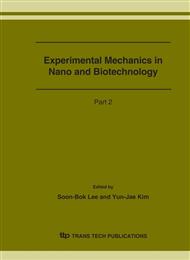p.1391
p.1395
p.1399
p.1403
p.1407
p.1411
p.1415
p.1419
p.1423
Structural Design of Piezoelectric Actuator Considering Polarization Direction and Continuous Approximation of Material Distribution
Abstract:
In the design of piezoelectric actuator the concept of compliant mechanism combined with piezoelectric materials has been used to magnify either geometric or mechanical advantage. The polarization of piezoelectric materials is considered to improve actuation since the piezoelectric polarization has influences on the performance of the actuator. The topology design of compliant mechanism can be formulated as an optimization problem of material distribution in a fixed design domain and continuous approximation of material distribution(CAMD) method has demonstrated its effectiveness to prevent the numerical instabilities in topology optimization. The optimization problem is formulated to maximize the mean transduction ratio subject to the total volume constraints and solved using a sequential linear programming algorithm. The performance improvement of Moonie actuator design confirms an effect of polarization direction and CAMD.
Info:
Periodical:
Pages:
1407-1410
Citation:
Online since:
December 2006
Authors:
Price:
Сopyright:
© 2006 Trans Tech Publications Ltd. All Rights Reserved
Share:
Citation:


